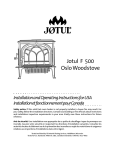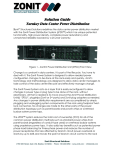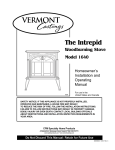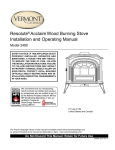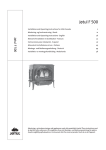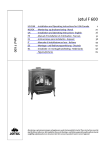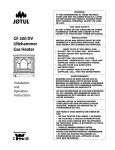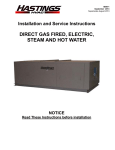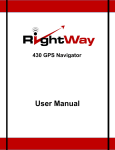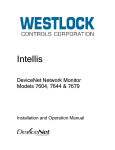Download Jotul F 3 User's Manual
Transcript
Jøtul F 3 CB Woodstove .................................... Installation and Operating Instructions for USA InstallationetfonctionnementpourCanada .................... Safety notice: If this solid fuel room heater is not properly installed, a house fire may result. For your safety, follow the installation directions. Contact local building or fire officials about restrictions and installation inspection requirements in your area. Kindly save these instructions for future reference. Avis de sécurité: Une installation non appropriée de ce poêle de chauffage risque de provoquer un incendie. Assurez votre sécurité en respectant les directives dinstallation suivantes. Consultez les autorités locales du bâtiment ou de la prévention des incendies au sujet des restrictions et exigences relatives aux inspections dinstallations dans votre région. Tested and listed by ITS Intertek Testing Services, Middleton, Wisconsin. Tested to U.S. Standards: ANSI/UL 1482, Canadian Standards: CAN/ULC-S627-M93 TABLE OF CONTENTS: 22 7/8 Standards and Safety Notices..........................3 Installations..........................................4 Chimney Requirements.............................6 Masonry Chimney.............6 Prefabricated Chimney.............6 Wall pass-throughs............7 Connecting to the Chimney.............................8 Masonry chimneys...............8 Hearthmount/Fireplaces...............9 Prefabricated Chimney...............9 Clearances........................................................10 Floor requirements.............10 Stove Clearances.............11 Wall shields.............12 Alcove Installations......................................13 Operation ......................................................14 Controls....................14 Breaking in your Stove...................14 Starting/Maintaining...................15 Formation of Creosote...................16 Maintenance..................................................16 Ash Removal...............16 Glass Care................16 General Maintenance................17 Gaskets................17 Accessories....................................................18 Firescreen.................18 Floor Bracket Kit.................18 Stove -Top Thermometer.................18 Parts Diagram..........................................18-19 Appendix A (alternate floor protection)............20 28 22 1/2 centerline of rear exit 20 1/4 with short legs installed 13 7 5/16 14 9/16 SAVE THESE INSTRUCTIONS AND MAKE THEM AVAILABLE TO ANYONE USING OR SERVICING THE STOVE. 2 STANDARDS NOTICES The F 3 CB wood stove has been tested and listed to; · BE SURE TO READ THIS ENTIRE MANUAL BEFORE YOU INSTALL OR USE YOUR NEW JØTUL F 3 CB WOOD STOVE. U.S. Standards: ANSI/UL 737 and ANSI/UL 1482. Canadian Standards: CAN/ULC-S627-M93 · IF THIS ROOM HEATER IS NOT PROPERLY INSTALLED, A HOUSE FIRE MAY RESULT. TO REDUCE THE RISK OF FIRE, FOLLOW THE INSTALLATION INSTRUCTIONS. FAILURE TO FOLLOW THESE INSTRUCTIONS MAY RESULT IN PROPERTY DAMAGE, BODILY INJURY, OR EVEN DEATH. · Jøtul recommends that you have your new Jøtul F 3 CB installed by a professional installer of solid fuel burning appliances. · EXTREMELY HOT WHILE IN OPERATION! KEEP CHILDREN, CLOTHING AND FURNITURE AWAY. CONTACT MAY CAUSE SKIN BURNS. · Avoid creating a low pressure condition in the room where the stove is operating. Operating an exhaust fan or a clothes dryer could create a low pressure area, causing poisonous gases to come out of the stove into the room. Tests performed by ITS, Intertek Testing Services, Middleton, WI Manufactured by Jøtul A.S.A., P.O. Box 135 Fredrikstad, Norway Distributed by Jøtul North America, P.O. Box 1157 400 Riverside Street Portland, ME 04104 This heater meets the U.S. Environment Protection Agencys Emissions limits for wood heaters manufactured and sold after July 1, 1990. Under specific test conditions, this heater has shown heat output at rates ranging from 11,500 to 43,500 BTUs per hour. The Jøtul F 3 CB wood is ONLY listed to burn wood . Do not burn any other fuels. JØTUL F 3 CB WOODSTOVE You can prevent low pressure conditions by providing adequate combustion air within 24 but not closer than 12 from the stove. Or, simply install the optional outside air manifold system, which allows the direct connection of air from outside the house to the stove. When installing, operating and maintaining your Jøtul F 3 CB woodstove, follow the guidelines presented in these instructions, and make them available to anyone using or servicing the stove. A number of areas require a building permit to install a solid fuel burning appliance. In the U.S., the National Fire Protection Associations Code, NFPA 211, Standards for Chimneys, Fireplaces, Vents and Solid Fuel Burning Appliances, or similar regulations, may apply to the installation of a solid fuel burning appliance in your area. In Canada, the guideline is established by the CSA Standard, CAN/CSA-B365-M93, Installation Code for Solid-Fuel-Burning Appliances and Equipment. Always consult your local building inspector or authority having jurisdiction to determine what regulations apply in your area. · Do not use chemicals or fluids to start the fire. Some fuels will, during combustion, separate carbon monoxide and generate it in the burn chamber. Carbon monoxide is toxic, so please follow the guidelines in this manual for proper operation of your Jøtul F 3 CB. · If you for some reason experience smoke rollout from the stove, it may activate smoke detectors if installed in the house. DO NOT CONNECT THIS STOVE TO ANY AIR DISTRIBUTION DUCT OR SYSTEM. 3 INSTALLATION REAR EXIT VENTING When rear exit venting is desired it will be necessary to knock-out the vent hole from the rear casting. IF THIS SOLID FUEL ROOM HEATER IS NOT PROPERLY INSTALLED A HOUSE FIRE MAY RESULT. FOR YOUR SAFETY, FOLLOW THE INSTALLATION DIRECTIONS. CONTACT THE LOCAL BUILDING OR FIRE OFFICIALS ABOUT RESTRICTIONS AND INSTALLATION INSPECTION REQUIREMENTS IN YOUR AREA. Remove the top casting of the stove by removing the two 3mm set screws that secures the top to the sides. The set screws are located on the outside of the stove on the top of each side panel. Reminder: Your local officials have final authority in determining if a proposed installation is acceptable. Any requirement, that is requested by the local authority having jurisdiction, that is not specifically addressed in THIS manual, defaults to NFPA 211, and local codes in the U.S. or in Canada, CAN/ CSA-B365-M and local codes. Using a 10mm wrench remove the double rear heatshields from the back of the stove. Remove the front door to avoid damage to the glass. Reminder: loss of the door washer will result in improper door alignment when reinstalling the door. Using a claw hammer or a small sledge hammer strike the CENTER of the 6 knock-out disc from the OUTSIDE of the stove. The knock-out disc will break into four wedges and may need to be tapped out. Touch up any remaining sharp edges with a file or hand grinder. INSTALLING THE VENTING The F 3 CB can be vented from the top, the rear or from either the right or left side. Follow the instructions below for the desired venting location. NOTE: The IVORY F 3 CBs ARE REAR VENTED FROM THE FACTORY. IT IS NOT NECESSARY TO KNOCK-OUT THE REAR CASTING OF THE STOVE. HOWEVER, IF TOP EXIT IS DESIRED IT IS NECESSARY TO INSTALL A SMOKE OUTLET COVER ON THE REAR OUTLET OF THE STOVE. TOP EXIT VENTING When top exit venting is desired, use a 3mm allen wrench to remove the two set screws that secure the top casting to the sides of the stove and lift off the top casting. Lay the top casting on a flat surface upside down and remove the 10mm bolt from the traverse bar and remove the smoke outlet cover. Reinstall the top casting, be sure to secure with the two set screws that were removed. See figure 1. UPSIDE DOWN TOP CASTING SPACERS STOVE PIPE STOP HEATSHIELD WITH LISTING LABEL 1234 1234 1234 1234 SHOULD BE INSTALLED ON THE FIGURE 2 OUTSIDE Reinstall the top casting and front door, remembering the washer. The two rear heatshields MUST be reinstalled on the stove. Remove the metal cover plates from the heatshields and reinstall. Reminder: there is a small nut used as a spacer between the two heatshields. See figure 2. 123 123 123 123 TRAVERSE BAR SECURING SMOKE OUTLET COVER TO TOP CASTING STOVE PIPE STOP FIGURE 1 4 STOVE PIPE CHIMNEY CONNECTOR SIDE EXIT VENTING If venting through the side is desired it will be necessary to remove the top casting. Using a 3mm allen wrench remove the two set screws that secure to the top to the side panels. Remove the front door to avoid damage to the glass. Reminder: loss of the door washer will result in improper door alignment when reinstalling the door. The chimney connector is a single walled pipe used to connect the stove to the chimney. For use with the F 3 CB the chimney connector MUST be 6 in diameter, with a minimum thickness of 24 gauge black steel. Aluminum and Galvanized steel pipe is not acceptable for use with the F 3 CB. These materials cannot withstand the extreme temperatures of a wood fire and can give off toxic fumes when heated. Using a claw hammer or a small sledge hammer strike the CENTER of the 6 knock-out disc from the INSIDE of the stove. The knock-out disc will break into four wedges and may need to be tapped out. Touch up any remaining sharp edges with a file or hand grinder. Reinstall the front door, remembering the washer and the top casting. Each chimney connector or stove pipe section must be installed to the stove flue collar and to each other with the male (crimped) end toward the stove. See figure 5. INSTALLING THE STOVE PIPE ADAPTER This prevents any amount of condensed or liquid creosote from running down the outside of the pipe or the stove top. All joints, including the flue collar connection must be secured with three sheet metal screws to ensure that the sections do not separate. After the appropriate flue outlet in the stove has been established the stove pipe adapter (included with every stove) must be installed so that standard stove pipe can be installed onto the stove. Insert the end of the adapter with the four holes into the stove. These holes allow the adaptor to be attached to the stoves internal collar, using the nuts and bolts provided with the stove. See figure 3. crimped end installed toward the stove FIGURE 5 DIRECTION INTO For the best performance the chimney connector should be as short and direct as possible, with no more than two 90° elbows. The maximum horizontal run is 36 and a recommended total length of stove pipe should not exceed 10 feet. Always slope horizontal runs upward ¼ per foot toward the chimney. THE STOVE FIGURE 3 The adaptor should be inserted into the stove until the bead on the adapter is flush with the top, back or side casting. Now the adaptor is ready to accept single or double walled stove pipe. See figure 4. No part of the chimney connector may pass through an attic or roof space, closet or other concealed space, or through a floor or ceiling. All sections of the chimney connectors must be accessible for cleaning. Where passage through a wall or partition of combustible construction is desired, the installation must conform with NFPA 211 or CAN/CSA-B365, and is also addressed in this manual. Each joint of chimney connector or stove pipe must be secured with at least three sheet metal screws to ensure that the sections do not seperate. ADAPTOR BEAD DO NOT CONNECT THIS UNIT TO A CHIMNEY FLUE SERVICING ANOTHER APPLIANCE. SHOULD BE FLUSH WITH STOVE FIGURE 4 Do not use the connector pipe as a chimney. 5 CHIMNEY REQUIREMENTS Masonry Chimneys There are two types of chimneys suitable for the F 3 CB: When installing the F 3 CB into a masonry chimney you must conform to all of the following guidelines: 1. A code- approved masonry chimney with a flue liner. · The masonry chimney must have a fireclay liner or equivalent, with a minimum thickness of 5/8 and must be installed with refractory mortar. There must be at least ½ air space between the flue liner and chimney wall. · The fireclay flue liner must have a nominal size of 8 X 8, and should not be larger than 8X 12. If a round fireclay liner is to be used it must have a minimum inside diameter of 6 and not larger than 8 in diameter. If a chimney with larger dimensions is to be used, it should be relined with an appropriate liner that is code approved. · The masonry wall of the chimney, if brick or modular block, must be a minimum of 4 nominal thickness. A mountain or rubble stone wall must be at least 12 thick. · A newly-built chimney must conform to local codes and in their absence must recognize national regulations. As a result, a short masonry chimney on the exterior of a house will give the poorest performance. This is because it can be very difficult to warm the chimney thereby creating inadequate draft. In extremely cold northern areas it may be necessary to reline the chimney or extend its height to help establish draft. · When using an existing chimney, it must be inspected by a professional licensed chimney sweep, fire official, or code officer, to ensure that the chimney is in proper working order. · No other appliance can be vented into the same flue. Oppositely, a tall masonry chimney inside the house is easier to keep warm and will perform the best. · An airtight clean-out door should be located at the base of the chimney. 2. A prefabricated chimney complying with the requirements for Type HT (2100°F) chimneys per UL 103 or ULC S629. The chimney size should not be less than the crosssectional area of the flue collar, and not more than three times greater than the cross-sectional area of the flue collar. When selecting a chimney type and the location for the chimney in the house, keep this in mind: it is the chimney that makes the stove work, NOT the stove that makes the chimney work. This is because a chimney actually creates a suction, called draft which pulls air through the stove. Several factors affect draft: chimney height, crosssectional area (size), and temperature of the chimney, as well as the proximity of surrounding trees or buildings. The following guidelines give the necessary chimney requirements based on the national code (ANSINFPA 211for the US. And CSA CAN-B365 for Canada). However, many local codes differ from the national code to take into account climate, altitude, or other factors. It is important that you check with your local building officials to find out what codes apply in your area before installing your new F 3 CB. Prefabricated Chimneys If a prefabricated metal chimney is to be used it must be a chimney type that is tested and listed for use with solid fuel burning appliances. High Temperature (HT) Chimney Standard UL 103 for the U.S. and High Temperature Standard ULC S-629 for Canada. 6 The manufacturers installation instructions must be followed precisely. Always maintain the proper clearance to combustibles as established by the pipe manufacturer. This clearance is usually a minimum of 2, although it may vary by manufacturer or for certain chimney components. WALL PASS-THROUGHS When your installation unavoidably requires the chimney connector to pass through a combustible wall to reach the chimney, always consult your local building officials, and be sure any materials to be used have been tested and listed for wall pass-throughs. Chimney Height In the U.S. Whether a masonry chimney or prefabricated metal chimney is used it must be the required height above the roof line. The National Fire Protection Associations publication, NFPA 211, Standard for Chimneys, Fireplaces, Vents and Solid Fuel Burning Appliances permits four methods for passing through a combustible wall. Before proceeding with any method be sure to consult with your local building officials to discuss any local code requirements. The requirement is: The chimney must be at least 3 feet higher than the highest point where it passes through the roof and at least 2 feet higher than the highest part of the roof or structure that is within 10 feet of the chimney, measured horizontally. See figure 6. Common Method When passing through a combustible wall to a masonry chimney this method requires the removal of all combustible materials from at least 12 around the chimney connectors proposed location. With a 6 round liner the minimum area required would be 31 x 31 square. The space is then filled with at least 12 of brick around a fireclay liner. Remember, the liner must be ASTM C35 or equivalent, with a minimum wall thickness of 5/8. It is important to remember to locate the pass-through at least 18 from the ceiling for proper clearance to combustibles. FIGURE 6 It will be necessary to cut wall studs, install headers, and construct a sill frame to maintain the proper dimensions and to support the weight of the brick. Chimneys shorter than 14 feet may not provide adequate draft. This could result is smoke spilling into the room from the stove when loading the stove, or when the door is open. In addition, inadequate draft can cause back puffing, which is a build up of gases inside the firebox. The bricks must be solid brick with a minimum of 3 ½ thick (4 nominal). Refractory mortar must be used at the junction of the chimney and the pass-through liner. The pass-through liner must not penetrate the chimney liner beyond the inner surface of the chimney liner. Use extreme care when constructing the hole in the chimney liner, the tiles can shatter easily. See figure 7. Other times, chimney height can create excessive draft which can cause high stove temperatures and short burn times. Excessive drafts can be corrected by installing a butterfly damper. If you suspect you have a draft problem, consult your dealer. 7 Consult your local building inspector, authorized Jøtul Dealer, NFPA 211 in the U.S. or CAN/CSA-B635 in Canada for other approved wall pass-through methods. CONNECTING TO THE CHIMNEY Masonry Chimney When installing a F 3 CB into a masonry chimney through a thimble(the opening through the chimney wall to the flue), the thimble must be lined with ceramic tile or metal and be securely cemented in place. The chimney connector/stove pipe must slide completely inside the thimble to the inner surface or the flue liner. It may be necessary to make use of a thimble sleeve (a pipe with a slightly smaller diameter than standard stove pipe). This special pipe can be easily installed into a thimble. See figure 8. FIGURE 7 In Canada The Canada the standard has been established by the Canadian Standard Association. The installation must conform to CAN/CSA-B365, Installation Code for Solid Fuel Burning Appliances and Equipment. Before proceeding be sure to consult your local building inspector. Make sure the connector pipe or thimble sleeve does not protrude into the flue liner, thereby restricting the area the smoke has to flow through. This bottle-neck will have a negative affect on the chimney system. Common Method The chimney connector should be sealed at the thimble with refractory cement and the stove pipe leading to the stove should have a minimum of three screws. This method requires the removal of all combustible materials from at least 18 (457mm) around the chimney connectors proposed location. With a 6 round liner the minimum area required would be 43 x 43 square. DO NOT CONNECT THIS STOVE TO A CHIMNEY FLUE SERVICING ANOTHER APPLIANCE OF ANY KIND. Connector pipe shall be flush with the inside of the flue tile It is important to remember to locate the pass-through at least 25 from the ceiling to maintain the proper clearance to combustibles. The space that is cleared of combustible materials must then remain empty. Sheet metal panels can then be used to cover the area. However, when using a panel on both sides of the wall each cover must be installed on noncombustible spacers at least 1 from the wall. If one panel of sheet metal is to be used it may be installed flush to the wall. Stove pipe connector Flue tile SEE SECTION 5.3.1 and 5.3.2 of CAN/CSA B365-M91. FIGURE 8 8 Thimble Hearth-mount into a Masonry Fireplace Fireplace installation must also observe the proper clearances to surrounding trim and mantels (addressed in clearance section of this manual). In addition, fireplace installations must also adhere to the floor protection guidelines specified in the following section. The F 3 CB may be installed into a masonry fireplace provided the opening is a minimum of 28 1/2 high. The short leg package reduces the stoves height by 2 1/4. When installing the F 3 CB into a masonry fireplace, code requires that the fireplace damper plate be removed or securely fixed in the open position. A connector pipe must then extend from the stoves flue exit through the damper area of the fireplace and into the chimney tile liner. See figure 9. The inside area of the flue liner must not be less than the area of the stoves flue exit, and cannot be more than three times greater than the cross sectional area of the stoves flue exit. Prefabricated Chimneys If the chimney liner is too large to accommodate the stove, an approved relining system must be installed to resize the flue. FIGURE 10 When installing the F 3 CB to a prefabricated metal chimney always follow the pipe manufactures instructions and be sure to use the components that are required. This usually includes some type of smoke pipe adapter that is secured to the bottom section of the metal chimney and allows the chimney pipe to be secured to it with three sheet metal screws. See figures 10 and 11. A new sheet metal damper block-off plate must be installed around the connector pipe at the damper frame and sealed with the proper sealant (usually High-Temp Silicone). TILE LINER CONNECTOR EXTENDS TO FIRST FLUE TILE DAMPER OPENING IS SEALED WITH SHEETMETAL PLATE AND SEALANT FIGURE 9 FIGURE 11 9 CLEARANCES TO COMBUSTIBLES Clearances to walls and ceilings Floor Protection The following clearances have been tested to UL and ULC standards and are the minimum clearances specifically established for the Jøtul F 3 CB. Floor protection under the F 3 CB woodstove, must be one of the following: 1. Any non combustible material with an insulative R value of 1.1. 2. Any UL, ULC or WH hearth board or prefrabricated non-combustible material. The bottom heatshield (standard equipment) is required in all installations. Individual sections of floor protection must be mortared together to prevent sparks from falling through to combustible materials. Any carpeting must be removed from under the floor protection. In the U.S.and Canada The F 3 CB must be installed on a non-combustible surface extending a minimum of 18 (460mm) in front of the stove and 8 (200mm) on the remaining sides of the stove (measured from side and back panels). This will result in a minimum floor protection of 41 D X 39 W See figure 12. In a rear vent installation the floor protection must also extend under the stove pipe a minimum of 2 (50mm) beyond either side of the pipe. 41 8 200mm 8 200mm front 18 460mm 39 WIDE FIGURE 12 A combustible surface is anything that can burn (i.e. sheet rock, wall paper, wood, fabrics etc.). These surfaces are not limited to those that are visible and also include materials that are behind non-combustible materials. If you are not sure of the combustible nature of a material, consult your local fire officials. Remember: Fire Resistant materials are considered combustible; they are difficult to ignite, but will burn. Also Fire-rated sheet rock is also considered combustible. Contact your local building officials about restrictions and installation requirements in your area. Using Shields to Reduce Clearances Pipe shields: When using listed pipe shields to reduce the connector clearance to combustibles, it must start 1 above the lowest exposed point of the connect pipe and extend vertically a minimum of 25 above the top surface of the stove. Double wall pipe: Listed double wall pipe is an acceptable alternative to connector pipe heatshields. Wall-Mounted Protection: When reducing clearances through the use of wall mounted protection: 8 200mm DEEP The following charts and diagrams give the required clearances you must maintain when installing the F 3 CB near combustible surfaces. In the U.S. refer to NFPA 211, Standard for Chimneys, Fireplaces, Vents and Solid Fuel Burning Appliances, for acceptable materials, proper sizing and construction guidelines. In Canada, refer to CAN/CSA-B365, Installation Code for Solid-Fuel Burning Appliances and Equipment, also for acceptable materials, proper sizing and construction guidelines. Stove mounted Rear Heatshield is standard equipment on all F 3 CB woodstoves. NO OTHER STOVE MOUNTED HEAT SHIELD MAY BE USED. 10 F 3 CB WOODSTOVE CLEARANCES* STOVE CLEARANCES TOP VENT/VERTICAL UNPROTECTED SURFACES PROTECTED SURFACES per NFPA 211 or CAN/CSA-B365-M SIDE 24" 610 mm REAR 25" 635 mm CORNER SIDE 18" 10" 460 mm 255 mm REAR 14" 355 mm CORNER 10" 255 mm Rear heatshield with 18" Double wall pipe or shields 460 mm 10" 255 mm 14" 355 mm 6" 150 mm 6" 150 mm Rear heatshield with Single wall pipe STOVE CLEARANCES REAR VENT/HORIZONTAL 6" 150 mm UNPROTECTED SURFACES PROTECTED SURFACES per NFPA 211 or CAN/CSA-B365-M SIDE 24 610 mm REAR 25 635 mm CORNER SIDE 20 10 510 mm 255 mm REAR 25 635 mm CORNER 18 460 mm Rear heatshield with 18 Double wall pipe or shields 460 mm 14 355 mm 17 430 mm 6 150 mm 6 150 mm Rear heatshield with Single wall pipe CONNECTOR CLEARANCES 6 150 mm UNPROTECTED SURFACE Single wall pipe-vertical installations Double wall pipe-vertical installations Single wall pipe-horizontal installations Double wall pipe-horizontal installations PROTECTED SURFACE per NFPA 211 or CAN/CSA-B365-M 18" (460mm) pipe mfgr. listing 18 (460mm) pipe mfgr. listing VERY IMPORTANT: 6" (150mm) pipe mfgr. listing 9 (230mm) pipe mfgr. listing MANTEL CLEARANCES Top Vent - Vertical: assumes the connector pipe runs from the top of the stove and travels vertically. If top vented to a horizontal run, the stove position is dictated by the connector pipe clearances. A B C Rear Vent - Horizontal: assumes the connector pipe extends from the rear of the stove and travels horizontally to the chimney. If rear vented to a vertical run, the stove position is dictated by the connector pipe clearances. D Dimensions in Inches represent U.S. requirements. Dimensions in Millimeters represent Canadian requirements. A = Top to Mantel B = Top to Top Trim C = Side to Side Trim D = Side to Side Wall: WALL PROTECTION IS DISCUSSED IN FURTHER DETAIL ON PAGE 12 OF THIS MANUAL. 11 34 20 13 24 860 mm 510 mm 330 mm 610 mm WALL SHIELDS FOR CLOSE CLEARANCE WALL SHIELD • • • • COMBUSTIBLE & WALL Must be 30” wide and centered behi nd the stove Must be 1” off the wall and 1” off the floor. With standard legs, the shield must be 32” high. With optional short legs, the shield must be 30” high. &20%867,%/( :$// WALL SHIELD • • • • Must be 1” off the wall and 1” off the floor. With standard legs, the shield must be 40” high. With optional short legs, the shield mus t be 38” high. Both shields MUST extend and join i n the c orner The wall shield must extend a minimum of 4” (102mm) past the side of the stove. The wall shield must extend a minimum of 4” (102mm) past the ash lip of the stove. &20%867,%/(: WALL WALL SHIELD • • • • Must be 1” off the wall and 1” off the floor. With standard legs, the shield must be 40” high With the optional short legs, the shield must be 38” high. Both shields must extend and join i n the corner. The wall shield must extend a mi nimum of 12” (305mm) past the front corner of the stove. The wall shield must extend a minimum of 12” (305mm) past the front c orner of the stove. 12 MINIMUM PROTECTED ALCOVE: NOTICE Accessories for woodstoves for clearance reduction have been developed by many manufacturers. If not following the methods of the installation codes, be sure that any accessory you choose has been tested by an independent laboratory and carries the laboratorys testing mark. Make sure to follow all of the manufacturers instructions. Assumestop exit, double wall pipe, and stoves rear heatshield. Minimum alcove width = 35 (890mm) Maximum alcove depth = 24 (610mm) Height above the top of the stove = 40 (1015mm) Always contact your local building inspector or fire officials about restriction and requirements in your area. Reminder, it is the local officials who have final authority in the installations approval. ALCOVE The F 3 CB is approved for installations in an unprotected and protected ALCOVE provided the following guidelines are followed: Stoves must be positioned as shown in figures 13 or 14. In a PROTECTED alcove installation both side walls and rear wall must be protected per NFPA 211 or CAN/CSA-B365. The wall protection must be elevated 1 from the floor and at least 1 off the combustible wall to allow for an air-flow. 6 150mm Alcove floor protection must be: a UL/ULC or WHI listed hearth board OR a non cmbustible material with a minimum R value of 1.1. MINIMUM UNPROTECTED ALCOVE: 6 150mm Assumestop exit, single wall pipe, and stoves rear heatshield. FIGURE 14 Minimum alcove width = 71 (1805mm) Maximum alcove depth = 40 (1015mm) Height above the top of the stove = 68 (1730mm) max. depth 24 (610mm) 24 610mm REAR EXIT ALCOVE INSTALLATIONS: Unprotected alcove: assumes single wall pipe and stoves rear heatshield. 71 min. (1805mm) 25 635mm Minimum alcove width = 71 (1805 mm) Maximum alcove depth = 40 (1015mm) Alcove ceiling above top of stove = 68 (1730mm) 24 610mm max. depth 40 (1015mm) 35 min. 890mm 10 255mm FIGURE 13 Protected alcove: assumes double wall pipe and stoves rear heatshield. Top vent/vertical- assumes the connector pipe is exiting off the top of the stove and traveling vertically. If top vented to any horizontal runs the stoves position is dictated by the connector pipe clearances. 13 Minimum alcove width = 35 (890mm) Maximum alcove depth = 30 (760mm) Alcove ceiling above top of stove = 40 (1015mm) WARNING: DO NOT INSTALL IN A BEDROOM/SLEEPING ROOM. THE STRUCTURAL INTEGRITY OF THE MOBILE HOMES FLOOR, WALL, CEILING/ROOF MUST BE MAINTAINED. OPERATION Before building a fire in your new F 3 CB, please read the following section carefully and completely. FIGURE 15 Do Not Burn First this stove is designed to burn natural wood ONLY, wood that has been air-dried for a period of 6 to 14 months will provide the cleanest most efficient heat. Do not burn: *Coal *Garbage *Cardboard *Solvents *Treated or painted wood *Chemical Chimney cleaners *Colored paper *Any synthetic fuel or logs The burning of any of these materials can result in the release of toxic fumes. Never use gasoline, gasoline-type lantern fuel, kerosene, charcoal lighter fluid, or similar liquids to start or freshen-up the fire. Always keep such liquids away from the heater at all times. IMPORTANT NEVER BUILD OR ALLOW THE FIRE TO REST DIRECTLY ON THE GLASS. THE LOGS SHOULD ALWAYS BE SPACED AT LEAST ONE INCH FROM THE GLASS TO ALLOW FOR PROPER AIR FLOW WITHIN THE STOVE. Controls on the F 3 CB FIGURE 11 START-UP AIR CONTROL LEFT = CLOSED POSITION RIGHT = OPEN POSITION PRIMARY AIR CONTROL FAR LEFT = LESS AIR, DIMINISHING THE HEAT OUTPUT FAR RIGHT = INCREASES AIR SUPPLY AND HEAT OUTPUT. When first starting a fire: the primary control lever should be at the far right position, and the start-up air lever should be in the far right position. This will allow for the maximum amount of air to enter the stove and assist in starting the fire quickly and most effectively. Once the fire is established the start-up air lever should be closed and the primary air lever should be adjusted according to the amount of heat desired. Remember: the more air entering the stove the hotter the fire the shorter the burn time. Moving the primary air lever to the left reduces the air-flow into the stove which prolongs the fire at a lower heat output. See figure 15. There are two air controls on the F 3 CB woodstove. The primary air control lever is located on the front of the stove in the top right corner. The primary air lever controls the amount of air that enters the stove for combustion. The start-up air control lever is located below the glass in the center of the front door. This control is for start - up air only and should not be used to freshen an existing fire or during refueling. Never leave the stove unattended while this control is open, overfiring could result which can damage the appliance. See figure 15. Breaking in your new stove Your new F 3 CB is constructed of cast iron and stove furnace cement. This type of construction requires the stove to be broken-in gradually so that heat expansion does not occur too quickly and cause damage. To monitor the stoves temperature, Jøtul recommends the use of a magnetic stove-top thermometer, placed directly on the corner of the stoves top plate. 14 Complete the following steps for the proper break-in procedure for the F 3 CB: 1. Light a small fire, newspaper and kindling only, only allow the stove to reach a maximum surface temperature of 200°. Burn for approximately 1 hour. 2. Allow stove to cool to room temperature. 3. Light a second fire, allowing the stove to reach a maximum temperature of 300° for 1 hour. 4. Cool the stove to room temperature. 5. Light a third fire and gradually allow the stove to reach a surface temperature of 400° 6. Cool stove to room temperature. This completes the break-in procedure. Never allow the stove to exceed a 400° surface temperature during any break-in fire with the exception of the last break-in fire. Note: IT IS NORMAL for a new painted stove to emit an odor and even smoke during its first several fires. This is caused by the seasoning of the high temperature paint and will diminish with each fire and will eventually disappear. Opening a window or door to provide additional ventilation will reduce the odor as this process takes its course. NEVER OVERFIRE THE STOVE. IF ANY PART OF THE STOVE OR CHIMNEY GLOWS, YOU ARE OVERFIRING, AND A HOUSE FIRE OR SERIOUS DAMAGE TO THE STOVE OR CHIMNEY COULD RESULT. IMMEDIATELY CLOSE DOWN THE AIR CONTROL IF YOU NOTICE THIS CONDITION. Starting and Maintaining a Fire Burn only solid wood directly on the bottom grate of the stove, do not elevate the fire in any way. The ash pan door on the stove must always be securely closed when the stove is in operation. Burning the stove with the ashpan open will over-fire the stove and cause interior damage. With the primary air control lever and the start-up air control lever in the full open position (far right), start with several sheets of crumbled newspaper placed directly on the grate. On top of the newspaper, place several pieces of small dry kindling (approx. 1 in diameter) with two to three larger logs (approx. 3 to 5 in diameter) on top. Light the fire and close the door, slowly building the fire by adding larger and larger logs. Close the startup air contrlo lever after the fire is established and new fuel lights easily. Be sure to follow the break-in procedure before creating a fire that will damage the stove. Once the stove has reached a surface temperature range of between 400° and 600°, adjust the primary air control lever as necessary to generate the heat output and burn time desired. Jøtul recommends the use of a magnetic stove top thermometer to monitor the surface temperature of the stove. The optimum surface temperature range for the most efficient burn is between 400° and 600°. See figure 16 below for the optimum locations of a stove-top thermometer. stove top thermometer stove top thermometer FIGURE 16 Adding Fuel When reloading the stove while it is still hot and a bed of hot embers still exist, follow this reloading procedure: · Always wear gloves when tending to the stove. · Push the air control lever to the full open position (far right). · Wait a few seconds before opening the door. · Use a stove tool or poker to distribute the hot embers equally around the firebox. · Load the fuel, usually with smaller logs first. · Close the door, be sure to latch the door tightly. · Wait 5 10 minutes before adjusting the primary air to the desired heat output setting. 15 (If you have at least a 2 thick ember bed when reloading, it may be possible to close the door and immediately adjust the air control setting). The Formation of Creosote When wood is burned slowly and at low temperatures, it produces tar and other organic vapors, which combine with moisture to form creosote. The slow moving smoke carries the creosote vapors, which condense in the cooler chimney flues, and this creosote then sticks to the chimney walls. The creosote that accumulates in the chimney is highly flammable and is the fuel of chimney fires. To prevent chimney fires it is important to have the chimney and chimney connector pipe inspected and/ or cleaned semi-annually. A qualified chimney sweep or other authorized service person can provide this service. It is also important to remember that chimney size, temperature and height all affect draft which in turn affects the formation of creosote. Be sure to follow the installation and operation guidelines established in this manual. The ashes should be placed in a metal container equipped with a tight sealing lid. The container should be placed on a noncombustible floor or on the ground, well away from all combustible materials, pending final disposal. If the ashes are disposed of by burial in soil or otherwise locally dispersed, they should be retained in the closed container until all cinders have thoroughly cooled. Glass Care: Cleaning: On occasion it will be necessary to clean the carbon deposits and fly ash off of the glass. If the carbon and fly ash are allowed to remain on the glass for an extended period of time it could eventually cause the glass to become etched and cloudy. Any creosote, which might deposit on the glass, will burn off during the next hot fire. The proper cleaning procedure is as follows: 1. Glass needs to be COMPLETELY COOL. 2. Only use a cleaner that is specifically designed for this purpose. The use of abrasives will damage the glass and ultimately leave the glass frosted. 3. Rinse and dry glass completely, before burning your stove. IMPORTANT: REPLACE GLASS ONLY WITH A CERAMIC GLASS PANEL SPECIFICALLY DESIGNED FOR THE JØTUL F 3 CB. DO NOT USE SUBSTITUTES. REPLACEMENT GLASS PANELS CAN BE ORDERED THROUGH YOUR JØTUL DEALER. MAINTENANCE Ash remomal: OF COURSE, FOR YOUR PROTECTION ALWAYS WEAR SAFETY GLOVES WHEN HANDLING THE ASH PAN. Ash removal will be required periodically depending on how frequently the stove is used. Conveniently, the F 3 CB is equipped with an ash pan assembly for easy ash removal, without the need for opening the front doors. The ash pan door is located under the front ashlip of the stove. To open the ash door insert the pin on the end of your specially designed ash tool into the hole on the ash door latch. Rotate the door counterclockwise to unlatch the door and clockwise to latch the door. Remove the ash pan. When the stove is in operation always close the ash pan door before leaving to dispose of the ashes. Glass Removal: Always operate the doors slowly and cautiously to avoid cracking or breaking the glass. Never use the door to push wood into the firebox. If the glass becomes cracked or broken follow this procedure for replacement: NEVER OPERATE THE STOVE WITH A CRACKED OR BROKEN GLASS PANEL. 1. Remove the door from the stove and place on a flat surface. 2. Carefully remove all of the glass clips from the inside of the door. 3. Gently remove all pieces of the glass panel and gasketing. 16 4. Remove all remaining debris from the glass area using a wire brush. 5. Apply a small bead of gasket/stove cement and the new gasket. Do not overlap the ends of the gasket rope. 6. Center the new glass panel over the gasket and reinstall the glass clips. See figure 17. IMPORTANT: The side of the glass treated with an infrared coating (marked on the perimeter) should always be facing outward. It is extremely important to tighten the glass clips slowly and in a repeating pattern, like tightening the lugs on an automobile wheel. 7. It may be necessary to retighten the glass clips after the stove has be burned and the gasketing has been seated. Gaskets Check door and window gaskets for tightness. To check the seal of the front doors, close and latch the doors on a dollar bill and slowly try to pull the dollar bill free. If it can be easily removed then the seal is too loose. Check several spots around the door, and repeat the procedure on the ash pan door as well. If gaskets need to be replaced, scrape out the old gasket and cement and clean the area with a wire brush. Apply a small bead of cement and push in the new gasket. After closing and latching the doors wipe clean, any excessive cement that has come from beneath the gasketing. door gasket GASKET LIST FOR THE F 3 CB glass Description Top Plate Gasket Ash Housing Gasket Ash Door Gasket Glass Gasket Door Gasket Air manifold Gasket FIGURE 17 glass clips General Maintenance Like your car, regular maintenance prolongs the life of your appliance. The following procedures do not take long and are generally inexpensive, but when done consistently, increase the life of your appliance and in turn, increase your years of enjoyment. At least once a year you should perform the following maintenance procedures: Thoroughly clean the stove. Enamel surfaces should be cleaned with soap and water. Empty stove of all soot and ashes. Only use a vacuum for this job if the vacuum is specifically designed for ashes. Inspect the stove; using a strong light inspect the stove inside and out for cracks or leaks. Replace all cracked parts and repair any cement leaks with furnace cement. 17 Order # 100038 128213 200024 200028 200024 200028 Size 3/8 LD Length 5'6 sheet gasket ¼ LD 3/16 LD 1/4 LD 3/16 3' 36 5' 16 The F 3 CB is designed to burn cleanly and efficiently when used according to the guidelines expressed in these operating instructions. However, to maintain the proper performance, a yearly chimney inspection and cleaning in necessary. Failure to keep the chimney system free of creosote and build up could result in a serious chimney fire. ACCESSORIES MAINTENANCE LOG Many accessories have been manufactured for use with the Jøtul F 3 CB. ONLY USE ACCESSORIES THAT ARE SPECIFICALLY DESIGNED FOR THE JØTUL F 3 CB. DATE: SERVICE PERFORMED: Firescreen (part # 350168) The F 3 CB has been approved for use as an open fireplace, with front door open. This feature is especially nice when the ambience of a fire is desired. Some care should be taken when operating the stove as a fireplace. · Always have the firescreen in place, attached to the stove front. · Never over load the stove, for the best appearance burn in the traditional three log configuration. · Reminder, when burning the stove with the screen in place, you are sacrificing efficiency for aesthetics, and you will be consuming wood at a much faster rate. WARNING: OPERATE YOUR JØTUL F 3 CB WITH THE FRONT DOOR FULLY OPEN AND THE FIRESCREEN IN PLACE OR FULLY CLOSED. A PARTIALLY OPENED DOOR MAY RESULT IN OVERFIRING. ALSO, IF THE DOOR IS LEFT PARTLY OPEN, GAS AND FLAME MAY BE DRAWN OUT OF THE STOVE OPENING, CREATING RISKS FROM BOTH FIRE AND SMOKE. BY: DATE: SERVICE PERFORMED: BY: DATE: SERVICE PERFORMED: BY: DATE: SERVICE PERFORMED: Floor Bracket Kit (part #750304) The optional Floor Bracket Kit can be used in the event the stove needs to be secured to the floor. Complete installation instructions and diagrams are supplied with each Floor Bracket Kit. BY: DATE: SERVICE PERFORMED: Stove-Top Thermometer (part # 5002) Jøtul recommends the use of a magnetic stove-top thermometer to monitor the surface temperature of the stove. The optimum surface temperature range for the most efficient, clean burn is between 400° BY: and 600°. 18 2B 2 22 15 62 59 57 6 52 55 7 51 12 11 8 46 31 26 24 22 29 45 19 42 35 64 65 73 70 76 EXPLODED VIEW OF THE F 3 CB APPENDIX A: ALTERNATE FLOOR PROTECTION F 3 CB PARTS LIST 2 2B 6 7 8 11 12 15 22 23 24 26 28 29 31 35 37 40 42 43 45 46 51 52 55 57 59 62 64 65 70 76 73 78 79 Inner rear heatshield Outer rear heatshield Smoke outlet cover Traverse bar Top plate with smoke cover Baffle plate Air distributor Back plate Side plate Back burn plate Right burn plate Air deflector Sliding air vent Front plate Log retainer Door Hinge pin Start-up air vent Door handle complete Locking bar Glass Sparkscreen Ashlip Leg Bottom plate Inner bottom plate Left burn plate Secondary air cover Flat ash housing gasket Ash housing Ashpan Ashpan door Stove tool Door latch Bottom heatshield All floor protection materials must be non-combustible ie. metal, brick, stone, mineral fiber boards). Any combustible material may not be used. The easiest means of determining if a proposed alternate floor material meets requirements listed in this manual is to follow this procedure. R-value = thermal resistance k-value = thermal conductivity C-value = thermal conductance 1. Convert the specification to R-value; a. If R-value is given, no conversion is needed. b. If k-value is given with a required thickness (T) in inches: R=1/k X T. c. If C-value is given: R=1/C. 2. Determine the R-value of the proposed alternate floor protector. a. Use the formula in Step 1 to convert values not expressed as R. b. For multiple layers, add R-values of each layer to determine overall R-value. 3. If the overall R-value of the sustem is greater than the R-value of the specified floor protector, the alternate is acceptable. EXAMPLE: The specified floor protector should be 3/4 thick material with a k-factor of 0.84. The proposed alternate is 4 brick with a Cfactor of 1.25 over 1/8 mineral board witha k-factor of 0.29. Step A. Use formula above to convert specifications to R-value. R=1/k X T= 1/.84 X .75 = .893 Step B. Calculate R of proposed system. 4 brick of C-1.25, therefore R brick = 1/C = 1/1.25 = 0.80. 1/8 mineral board of k = 0.29 therefore R mineral board = 1/.29 X 0.125 = 0.431 Total R = R brick + R mineral board= 0.8 + 0.431=1.231 Step C. Compare proposed system R = 1.231 to specified R of 0.893. Since R is greater than required, the system is acceptable. Definitions: Thermal conductance = Btu 2 C = (hr)(ft )(F) Thermal conductivity = = Btu 2 = k = (hr)(ft )(F) Thermal resistance = Btu 2 R = (hr)(ft )(F) ONLY USE REPLACEMENTS PARTS PROVIDED THROUGH YOUR AUTHORIZED JØTUL DEALER. W (m2)(K) W = (Btu) (m2)(K) (hr)(ft)(F) = (m2)(K) W = (Btu)(inch) (hr)(ft2)(F) FOR THE JØTUL F 3 CB WOOD STOVE REQUIRES FLOOR PROTECTION WITH A MINIMUM INSULATING R VALUE OF 1.1. ALCOVE INSTALLATION REQUIRE A MINIMUM R VALUE OF 1.1. (IF A UL/ULC or WHI LISTED HEARTH PAD IS NOT USED.) 20 Stoves and fireplaces must be installed to conform to local and national building regulations. Before preparing for the installation of the appliance, it is important that the instructions issued with the unit are carefully read and strictly adhered to. Jøtul pursue a policy of constant product development. Products supplied may therefore differ in specification, colour and type of accessories from those illustrated and described in the brochure. Jøtul vise sans cesse à améliorer ses produits. Cest pourquoi, il se réserve le droit de modifier les spcifications, couleurs etéquipement sans avis prélable Jøtul ASA P.O Box 1411 N-1602 Fredrikstad, Norway Jøtul North America 400 Riverside Street Portland, Maine 04104 REV 2000.1





















